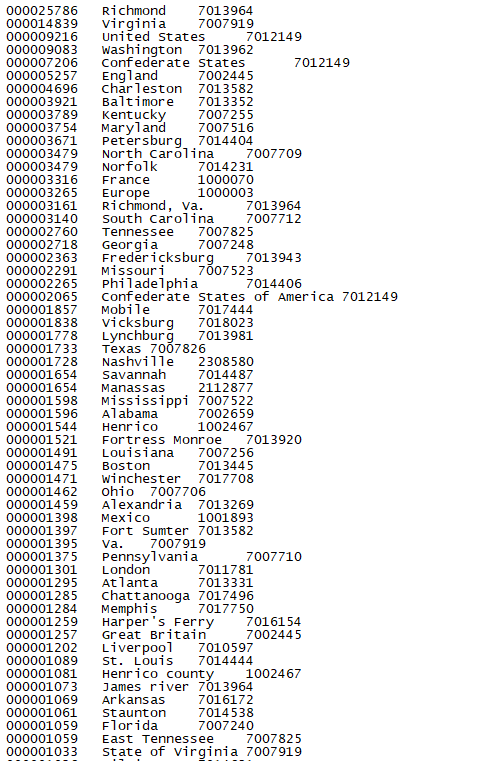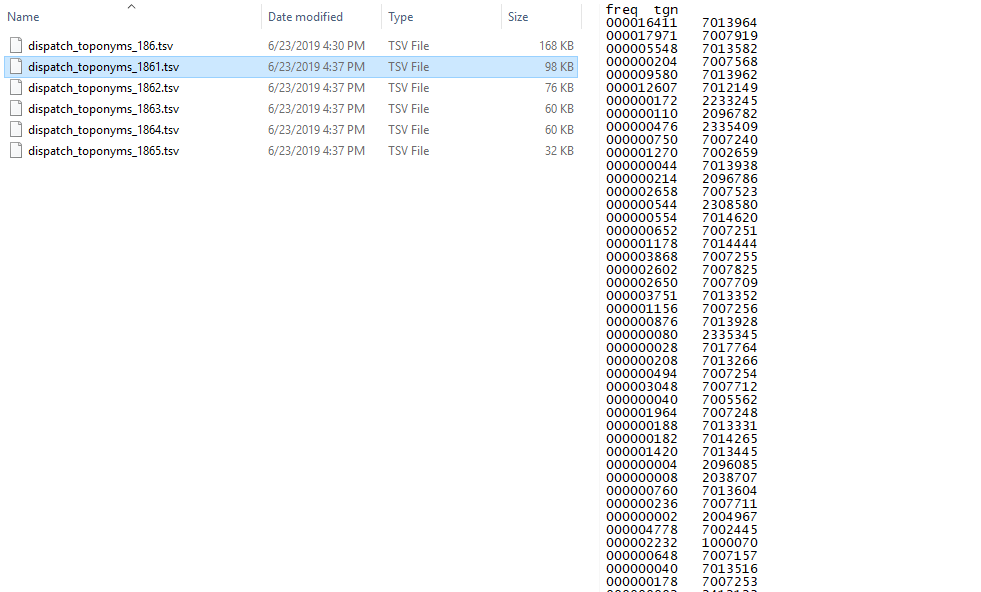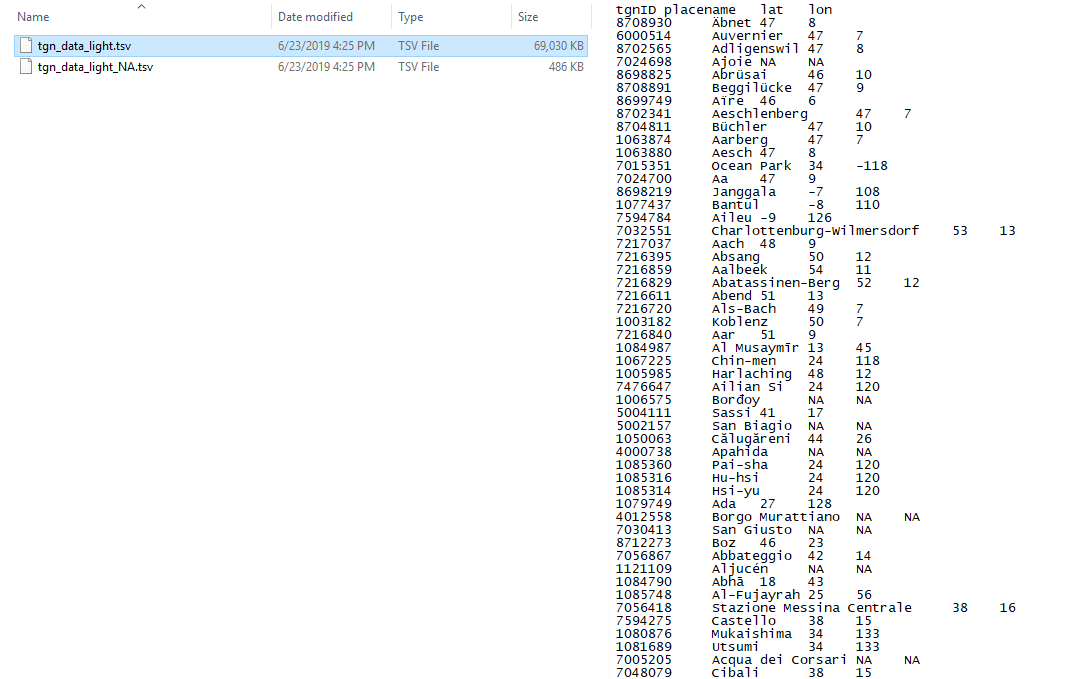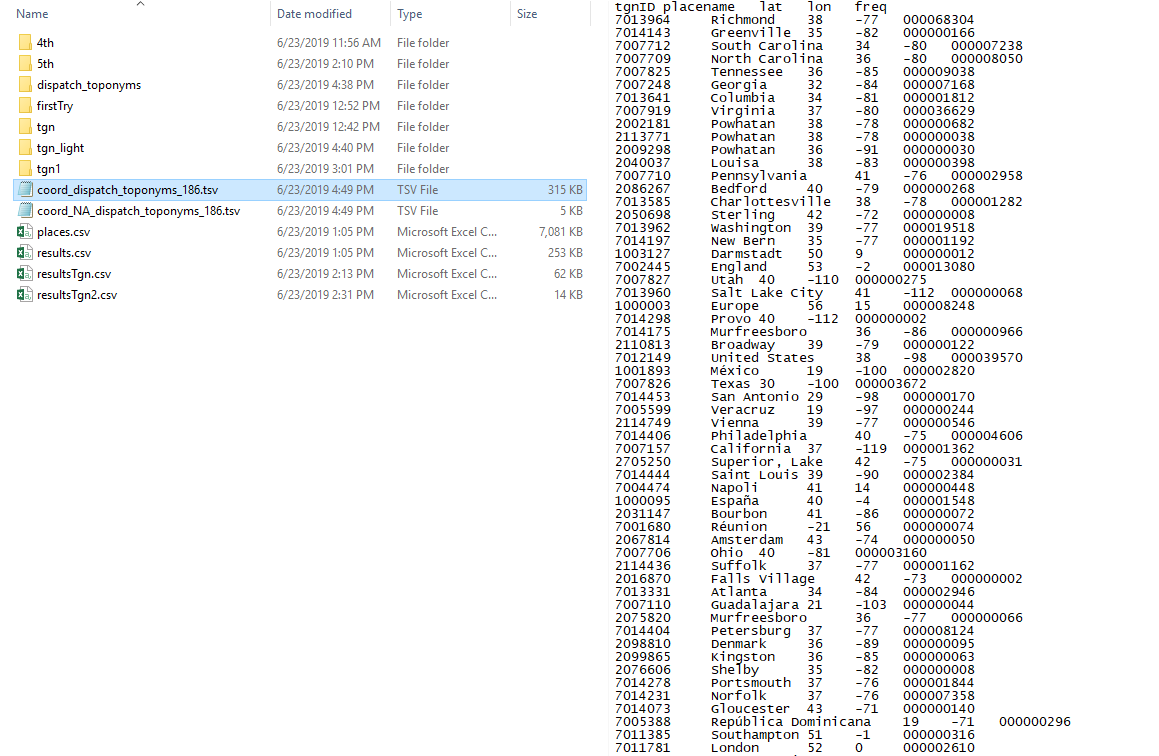Python Functions for retrieving data from two databases and matching values to create a Map
Code example one to retrieve Placenames and TGN number with BeautifulSoup
from bs4 import BeautifulSoup
import re
import os
newPathToFolder = "---path to target folder---"
pathToFolder = "---path to source folder---"
listOfFiles = os.listdir(pathToFolder)
dicFreq = {}
placeNames = []
resultsCSV = []
# for loop that opens all files of a defined folder and stores it with BeautifulSoup in variable soup
for f in listOfFiles:
soup = BeautifulSoup (open(pathToFolder+f, "r", encoding="utf8"), features="html.parser")
# searches for list items of "date" and return maximum two elemens
issue_date = soup.find_all("date", limit=2)[1] # only returns the second match
issue_date = issue_date.get("value")
# searches for all tags with "div3" and stores it in variable "articles"
articles = soup.find_all("div3", type = True)
# Searching for "placename" with a "key" attribute
for a in articles:
places = a.find_all("placename", key = True)
# Pulling out the text of "placename" as well as the value of the attribute "key"
for p in places:
# finding the placename
place = p.get_text()
# finding the key but only if it is a digit
keyTmp = [d for d in p['key'] if d.isdigit()]
# joining keys
key = "".join(keyTmp)
# creating a tab seperated list
placeList = "\t".join([place,key])
# appending the tab sepreated list to one list
placeNames.append(placeList)
# Creating a frequency counter
for i in placeNames:
if i in dicFreq:
dicFreq[i] += 1
else:
dicFreq[i] = 1
# formatting the frequency counter
for key, value in dicFreq.items():
if value > 1: # this will exclude items with frequency 1
newVal = "%09d\t%s" % (value, key)
# newVal will looks like: `000005486 TAB Richmond`
resultsCSV.append(newVal)
resultsCSV = sorted(resultsCSV, reverse=True)
print(len(resultsCSV)) # will print out the number of items in the list
resultsToSave = "\n".join(resultsCSV)
# creates a new file in a target folder with name + article counter + name + issue_date + txt file
newfile2 = newPathToFolder + "results.csv"
# opens the newfile and writes each article into a sperate file
with open(newfile2, "w", encoding="utf8") as f8:
f8.write("".join(resultsToSave))
Result with BeautifulSoup

Code example two to retrieve Placenames and TGN number with Regex
import re, os
source = "dispatach source files folder path"
target = "target path to save the new created files"
lof = os.listdir(source) # listing the source directory
counter = 0 # general counter to keep track of the progress
def generate(filter): # defining a function with one argument
topCountDictionary = {} # empty dictionary
print(filter)
counter = 0
for f in lof: # for loop to search in all files of a selected folder
if f.startswith("dltext"): # fileName test # if condition to search in files starting with the string "dltext" only
with open(source + f, "r", encoding="utf8") as f1: # if the above condition is true it opens the files and reads them
text = f1.read() # the loaded file is stored in the variable "text"
text = text.replace("&", "&") # search and replace function that removes "amp;"
# try to find the date
date = re.search(r'<date value="([\d-]+)"', text).group(1) # search with regular expression to find the date of each article
#print(date)
if date.startswith(filter): # if condition that allows to search for specific dates in the articles
for tg in re.findall(r"(tgn,\d+)", text): # for loop to find all tgn numbers in the articles of the previous specified date
tgn = tg.split(",")[1] # creates a new variable and split the previous found string by comma and uses the second item which is the tgn number
if tgn in topCountDictionary: # if condition to create a counter if a new tgn number was found
topCountDictionary[tgn] += 1
else: # else the counter remains 1
topCountDictionary[tgn] = 1
#input(topCountDictionary)
top_TSV = []
for k,v in topCountDictionary.items(): # for loop to search for item of the topCountDictionary dictionary
val = "%09d\t%s" % (v, k) # defines the format of the frequency counter
#input(val)
top_TSV.append(val) # appends the frequency to a list
# saving
header = "freq\ttgn\n" # creates a header for the final tsv table
with open("dispatch_toponyms_%s.tsv" % filter, "w", encoding="utf8") as f9: # writing the data into a tsv file
f9.write(header+"\n".join(top_TSV))
#print(counter)
#generate("186")
generate("1861") # example to use defined function with a specifc date
generate("1862")
generate("1863")
generate("1864")
generate("1865")
Results for Regex

Code example three to simplify the TGN database with regular expression
import re, os
source = "tgn xml files source path"
target = "target folder to save the new file"
def generateTGNdata(source): # creating a function with one argument
lof = os.listdir(source) # loading the source directory
tgnList = [] # creating a new list
tgnListNA = [] # creating a new list
count = 0 # creating a counter
for f in lof: # for loop to search a files of the source directory
if f.startswith("TGN"): # fileName test
print(f)
with open(source+f, "r", encoding="utf8") as f1: # opens all files that are true in the previous fileName test
data = f1.read() # stores the read data in a new variable
data = re.split("</Subject>", data) # splits the data by closing tag
for d in data: # for loop to search each subject previously splitted
d = re.sub("\n +", "", d) # subetting with a regular expression to remove/replace all new lines
#print(d)
if "Subject_ID" in d: # if condition to search if a Subject_ID tag is available
# SUBJECT ID
placeID = re.search(r"Subject_ID=\"(\d+)\"", d).group(1) # regular expression search for the Subject_ID value defined as group one
#print(placeID)
# NAME OF THE PLACE
placeName = re.search(r"<Term_Text>([^<]+)</Term_Text>", d).group(1) # regular expression search for place names defined in the xml as Term_Text tag
#print(placeName)
# COORDINATES
if "<Coordinates>" in d: # if condition to search if a Coordinates tag is available
latGr = re.search(r"<Latitude>(.*)</Latitude>", d).group(1) # regular expression to search for the value of the Latitude tag as group one
lat = re.search(r"<Decimal>(.*)</Decimal>", latGr).group(1) # regular expression to search for a the value of the Decimal tag but only with the previous Latitude result
lonGr = re.search(r"<Longitude>(.*)</Longitude>", d).group(1) # regular expression to search for the value of the Longitude tag as group one
lon = re.search(r"<Decimal>(.*)</Decimal>", lonGr).group(1) # regular expression to search for a the value of the Decimal tag but only with the previous Longitude result
#print(lat)
#print(lon)
else: # else lat and long is NA
lat = "NA"
lon = "NA"
tgnList.append("\t".join([placeID, placeName, lat, lon])) # appending the final strings to a list joined as tab seperated
#input(tgnList)
if lat == "NA": # all NA values are stored in a seperate list
print("\t"+ "; ".join([placeID, placeName, lat, lon]))
tgnListNA.append("\t".join([placeID, placeName, lat, lon]))
# saving
header = "tgnID\tplacename\tlat\tlon\n" # creating a header for the tsv tables
with open("tgn_data_light.tsv", "w", encoding="utf8") as f9a: # saving the list as tsv original
f9a.write(header+"\n".join(tgnList))
with open("tgn_data_light_NA.tsv", "w", encoding="utf8") as f9b: # saving the NA list as tsv
f9b.write(header+"\n".join(tgnListNA))
print("TGN has %d items" % len(tgnList)) # print function to see how many items are found
generateTGNdata(source) # example of how to use the new function
Results to Regex Continued

Code example four to generate a dictionary of TGN numbers and coordinates and match it with TGN numbers and placenames
import re, os
def loadTGN(tgnTSV): # creates a new function with one argument
with open(tgnTSV, "r", encoding="utf8") as f1: # opens a file defined in the function argument
data = f1.read().split("\n") # reads the file and stores the data splitted by new lines
dic = {} # creates an empty dictionary
for d in data: # for loop to search items of the loaded data
d = d.split("\t") # splits the data by tab
dic[d[0]] = d # saves the data in the dictionary starting at the first entry
return(dic) # to return the dictionary
def match(freqFile, dicToMatch): # new function with two arguments
with open(freqFile, "r", encoding="utf8") as f1: # opens the first file later defined as the first argument
data = f1.read().split("\n") # loads the data as variable and splits it by new lines
dataNew = [] # creating a new empty list
dataNewNA = [] # creating a new empty list
count = 0 # creating a counter
for d in data[1:]: # for loop to search each item of the loaded data
tgnID = d.split("\t")[1] # splits each item by tab for the second colum of the loaded data
freq = d.split("\t")[0] # splits each item by tab for the first column of the loaded data
if tgnID in dicToMatch: # if condition to match the tgnID of the loaded data (first argument) with the tgnID of a new file (second argument)
val = "\t".join(dicToMatch[tgnID]) # found matches are stored in a new variable that joins them tab seperated
val = val + "\t" + freq # reformatting the variable to add the frequency to the tgnID
if "\tNA\t" in val: # if condition to searchfor NA values in the new variable
dataNewNA.append(val) # if found it appends it to the NA list
else:
dataNew.append(val) # else it appends it to the regular list
else:
print("%s (%d) not in TGN!" % (tgnID, int(freq))) # prints information in the console about not found data in the tgn file
count += 1
header = "tgnID\tplacename\tlat\tlon\tfreq\n" # creates a header for the tsv file
with open("coord_"+freqFile, "w", encoding="utf8") as f9a: # saves the tsv file with found results
f9a.write(header + "\n".join(dataNew))
with open("coord_NA_"+freqFile, "w", encoding="utf8") as f9b: # saves the tsv file of the not found NA data
f9b.write(header + "\n".join(dataNewNA))
print("%d item have not been matched..." % count) # prints to the console the amount of files not found
dictionary = loadTGN("tgn_data_light.tsv") # loads the function for the tgn data file and stores it as dictionary in a new variable
match("dispatch_toponyms_1861.tsv", dictionary) # example of how to use the match function
match("dispatch_toponyms_1862.tsv", dictionary) # the first argument is the filename (must be stored in same folder path)
match("dispatch_toponyms_1863.tsv", dictionary) # the second argument uses the previous loaded dictionary to match items with
match("dispatch_toponyms_1864.tsv", dictionary)
match("dispatch_toponyms_1865.tsv", dictionary)
Matching results
